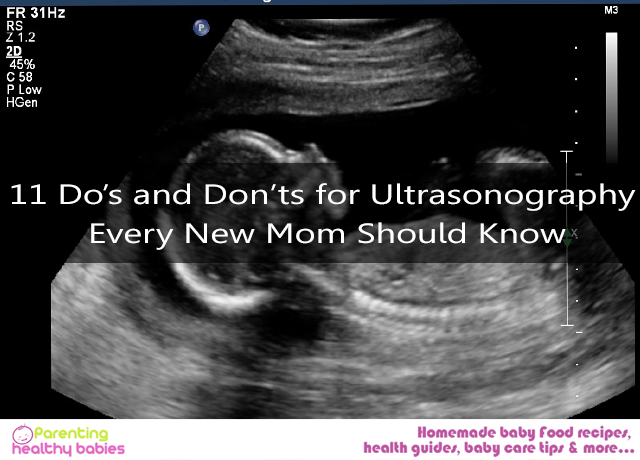Being pregnant is a great responsibility. A new life is budding inside you. These 9 months are not going to be simple at all; they will be full of various tests, mood swings, emotional moments and pain. To help you in all your new experience we would like to help you to know about one of the most important tests ‘ultrasonography’
Ultrasonography is done to keep track of your baby’s growth and development. By this technique, we can view the baby clearly by exposing it to minimum radiations. Ultrasonography involves radiating sound waves that are beyond human hearing, those waves touch the tissue and then return, giving us the image of the baby.
Types of images
- B-mode– It is brightness mode 2d image. It gives the idea about width and brightness of the organ. If there are no risks to the baby or the mother, this type is preferred so that we just get a proper idea about its width and growth.
- M-mode– when we want to look at moving organ like heart these images are obtained, so that you can hear and see your baby’s heart beats.
- Colour Doppler and pulse wave– colour Doppler is not done normally. It is done to look mainly at the direction, velocity and presence of blood flow. When the blood flows towards the wave transducer, it is red and flow away is blue. It is done when we suspect any blood anomalies in baby.
- 3d ultrasound– gives life like images. All planes of baby can be seen. Images can be reconstructed using computers. It is mainly used to check any congenital anomaly.
Advantages are
- Complete structural view
- Stored data can be reviewed any time without need of patient. So easy for 2nd opinion
- Prenatal diagnosis improves.
- Parent antenatal bonding improves.
However, it should not replace 2d ultrasound. 3d ultrasound should be done only when needed.
Types of views
- Trans abdominal– most commonly done. In this doctor will apply the gel to abdomen and the stick like structure which is the transducer will glided over your abdomen, thus we can get the images of baby
- Trans vaginal– when doctor needs a better view Trans vaginal view is preferred. This is because there are less obstructions and better view is obtained.
Why it is done?
- 1st trimester–
- Gestational age– age of pregnancy is known. And accordingly development is also seen and assessed.
- Ectopic pregnancy– if there is an ectopic pregnancy, it can be well known in advanced. So that we can prevent complications.
- Multiple pregnancies– you will know about number of foetus present. If you are going to have twins you will get to know at this stage.
- Foetal anomalies– anatomical anomalies, though not specifically, but some obvious like anencephaly can be known.
- Confirm cardiac activity– your pregnancy is confirmed by the cardiac activity of your baby.
- 2nd trimester–
- Gestational age– gestational age for assessing development and growth.
- Amniotic fluid volume– baby stays in amniotic fluid all throughout pregnancy. It keeps the temperature constant. And also act as cushion. So it is very necessary that it is optimum.
- Foetal anomalies
- Foetal growth
- Foetal presentation– the position of baby can be seen now. If it is normal, we can expect a normal delivery. If not, you will be guided through options of assisted deliveries and c-section.
- 3rd trimester
- Detailed anatomical survey of foetus– it is not needed normally, as till now we have been keeping track of baby’s development. But in some cases with some history of small anomalies it can be done.
- Estimated foetal weight– baby’s weight can be estimated and we can prepare for complications if baby is low birth weight. Thus increasing chance of successful pregnancy.
Procedure
When you go for your appointment, you will either be asked to change or uncover your abdomen, for Trans abdominal ultra sound. For Trans vaginal ultrasound, you will be made to sleep on a special table, with your legs spread. The contact gel is applied on abdomen, it is clear and non sticky. Then a wand like transducer is moved over the belly for images at various angles. In transvaginal, the wand is moved near your cervix to obtain better images.
11 Do’s and Don’ts for Ultrasonography Every New Mom Should Know
Dos before going to ultrasound
- DO start preparing in advance. Drink plenty of water 2-3 weeks before, it will help to have clear amniotic fluid for better images.
- Do ask all your doubts to your doctor before hand. Doctors may have preference about completely full bladder and half filled bladder, do not forget to ask about that.
- Do be comfortable during the test, urinate 1 hr before the appointment and then drink during 3-4 glasses of water. So that your bladder is full but you are not that uncomfortable.
- Do have food as normal. Avoid fasting before test. But avoid greasy and fatty food.
- Do relax yourself. It is a painless test and you will be able to see your baby!
- Do talk to an experienced person beforehand. Do not rely on any kind of rumour.
- Do take a person with whom you are comfortable. This will make you comfortable and also you can share your bundle of joy with someone!
- Do wear loose 2 piece clothing, so that it is comfortable undressing. Normally the gel is clear and non-sticky; it doesn’t leave any stains on clothing.
- Do take your medicines as prescribed. Also ask your doctor for any special instructions.
- Do give your doctor an accurate medical history. This is very important as doctor will assess your reports accordingly.
- Be open about your fears to the doctor, if needed you can take a pre counselling session. But be sure to be well informed and stress free. It helps in growth and development of the baby.
Don’t s
- Do not empty your bladder before the test. A full bladder ensures better images.
- Do not consume greasy and oily food a night before.
- Avoid wearing tight cloth. Tight clothes are very uncomfortable while changing.
- Do not skip your medications until informed. Take your medicines as prescribed and on proper time.
- Do not believe on myths. Rely on trusted source of information.
- Do not lie about any symptom to your doctor. Doctor has to assess the growth and development of your baby. He will do according to your given history and reports. Do not lie about any medical history or any history asked.
- Do not stress yourself. Stress will just make you more and more anxious. It may make the baby uncomfortable also. De-stress yourself with light exercise or yoga.
- Do not make yourself uncomfortable. If your bladder is too full and you are very uncomfortable, just lighten up a bit, do not bear till it pains.
- Do not move during test. Normally this doesn’t make much difference but still, staying still gives better image.
- Do not apply any powders lotion over your belly. They will decrease the efficacy of the contact lotion.
- Do not miss your appointments. Regular ultrasound is recommended to check your baby’s development and growth. It is recommended only when required. So if required, do not miss it.
These were some dos and don’ts before your ultrasonography. Ultrasonogrphy is a great diagnostic too. It will help to keep you your baby safe. Also it helps in developing bond during the pregnancy. And you get to meet your baby at regular intervals. Also various anomalies and defects can be diagnosed, treated, prevented and prepared in advanced. I am sure you will enjoy this period. Wish you and your baby a healthy life.













